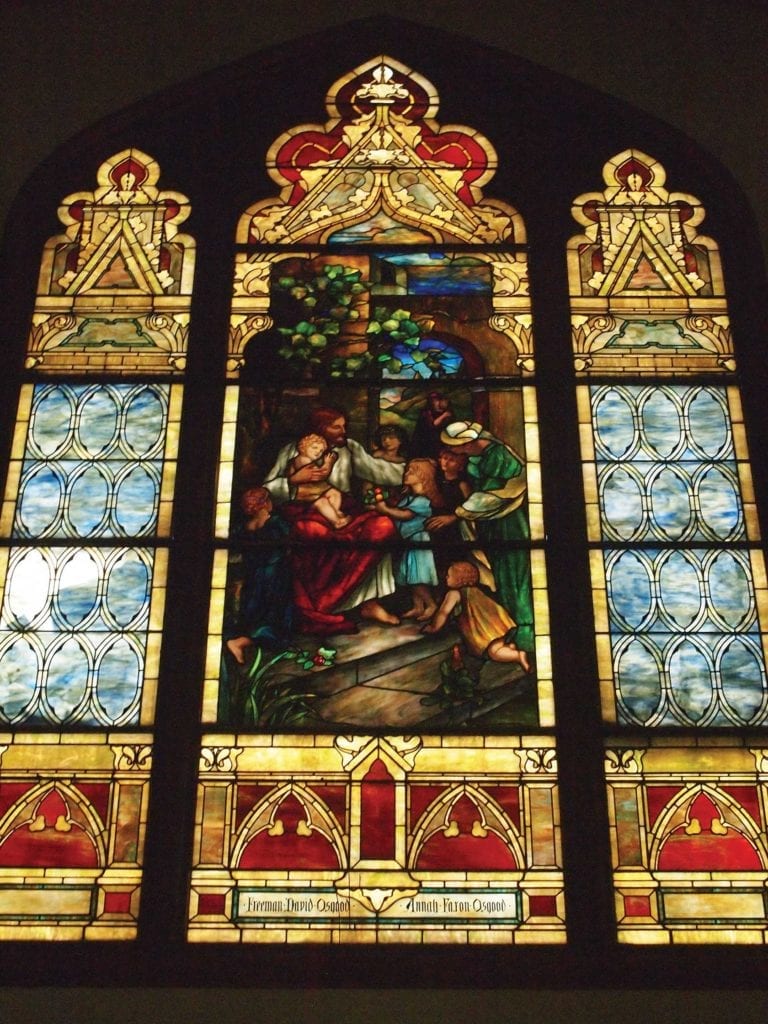Housing, work space under consideration for St. James African Orthodox Church building
Historic Boston will build apartments in basement, housing on parking lot

The historic St. James African Orthodox Church in Roxbury will become housing and a new community space.
The church, purchased by nonprofit Historic Boston Inc. last July from City Realty for $1.4 million, was the subject of a long battle between community members and the developer, which had planned to demolish it and build housing units.
Now, HBI Executive Director Kathy Kottaridis says HBI will preserve the 1910 building in the Fort Hill neighborhood, developing housing, community space and offices or artist studios.
“There’s natural barriers to easy development, so that’s going to be a challenge, but the feeling is that this could be a really interesting space that we could leave open for the community and that we could also have a revenue-generating use in it as well,” she said.
On a rainy day last week, Kottaridis inspected the building, pointing out areas in the pressed-tin ceiling and walls where water was dripping through and the now-blocked up holes where HBI discovered raccoons and opossums coming in when it first acquired the property.
She explained that the basement of the church will become four or five rental apartments, while more housing will most likely be built where the building’s parking lot was. The main nave of the church, where services were held, will be converted into a community space of some kind, although HBI is not entirely sure yet what that will be.
“We’d like to keep as much of a sense of the open space as possible. We’re thinking about [artist] workspaces or office space for nonprofits,” Kottaridis said.
HBI is also considering keeping the space as a meeting area, possibly run in cooperation with the Nathan Hale School across the street.
The construction will not be easy: even putting aside the deterioration of the building, which has been vacant since 2015 when the congregation sold it to City Realty, elements like sloping floors and stained-glass windows make it difficult to convert, and the organization is limited in what it can change due to the building’s status as a historic landmark.
Kottaridis said that ideally, they would start by building the new construction on the property’s parking lot, then use the proceeds from selling those homes to fund the renovation.
“But the truth is, every time that we come out here and we see the degradation, we almost feel like there’s a level of envelope work that we might need to do here sooner, which is costly, but it might be more costly to wait a year or two,” she said.
The stained-glass windows create a unique problem. Some of the existing windows are missing panels, and others are cracked, but none lets in sufficient light for any of the proposed uses of the space. At the same time, HBI may not be allowed to replace them with clear glass due to regulations on renovations of the landmark building, or may need to display them elsewhere in the building instead of removing them altogether.
History of the building
When the church, designed by Bostonian architect Edward T. P. Graham, was built in 1910, it was the home of the Norwegian Free Evangelical Church, but was sold to the African Orthodox Church in 1955.
The last remaining members of that church sold it to the developer in 2015. They had looked for another church to purchase it but couldn’t find a congregation with the means to restore the building.
City Realty had actually attempted to sell the property to HBI in 2016, but the nonprofit, which had just purchased the Fowler Clark Epstein Farm in Mattapan, was not financially able to reach an agreement with the developer, Kottaridis said.
Then came the battle: the developer planned to demolish the building, or build next to it and leave it to deteriorate on its own time, but the community wasn’t having it. The Highland Park Neighborhood Coalition collected over 2,700 signatures of nearby residents and successfully petitioned the city’s Landmarks Commission to grant the building emergency landmark status, preventing the anticipated demolition.
Hints of the church’s history are still around in the building. In addition to debris from the lives of the now-disbanded congregation, including a backroom thrift store full of old stock and dusty hymnals sitting on the theater-style folding chairs, the stained-glass windows and decor bear the names of both Norwegian and African Orthodox members.
Restoring the building
HBI is in the process of choosing an architect that Kottaridis and her team believe can solidify their vision for the property and can handle both the preservation of the original church and the new construction of housing, Kottaridis said.
“That’s the next big step, and then we begin to talk to the lawyers and the zoning people and the neighborhood,” she said.
While the process will be difficult, Kottaridis thinks that the final product can be a welcoming space that will engage the full community.
“It’s daunting, but it is exciting,” she said.






